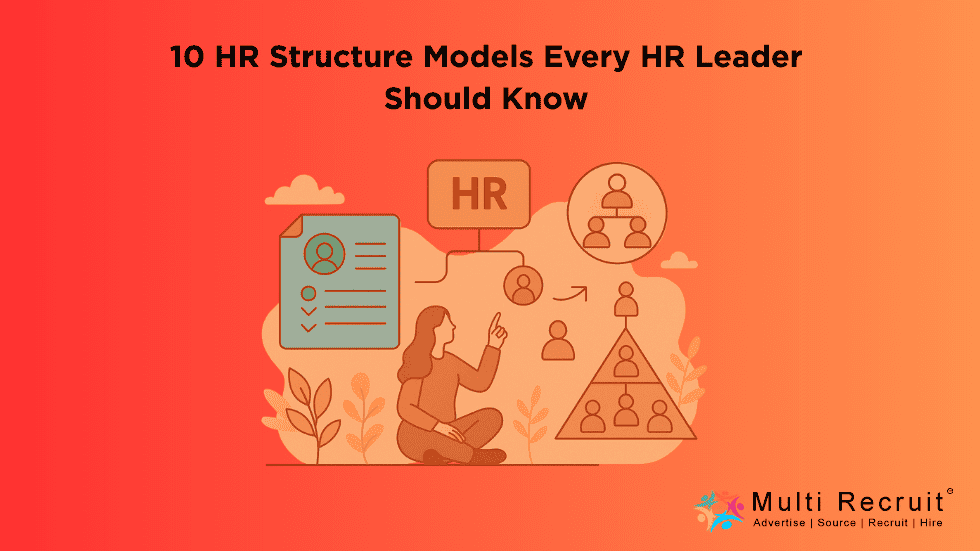As the workplace evolves in 2025, HR leaders face unprecedented challenges, from AI integration to hybrid work environments and employee expectations for personalized experiences. At Multi Recruit, we understand that effective HR structure models are critical for aligning human resources with business strategy, fostering innovation, and driving organizational success. Below, we explore 10 essential HR models that every HR leader should master to navigate the dynamic landscape of talent management in 2025.
What are the 10 HR Structure Models?
1. The Ulrich Model
Developed by Dave Ulrich in 1996, the Ulrich Model remains a cornerstone for structuring HR functions, particularly in large organizations. It divides HR into four roles: Strategic Partner, Change Agent, Administrative Expert, and Employee Champion. In 2005, Ulrich expanded this to include a fifth role, HR Leader, emphasizing leadership in aligning HR with business goals. This model is vital for creating efficiency by separating transactional and strategic tasks, though it requires clear role definitions to avoid silos. For Multi Recruit clients, this model helps streamline operations while fostering strategic alignment.
2. The HR Value Chain
The HR Value Chain, based on Jaap Paauwe and Richard Richardson’s 1997 work, connects HR functions to organizational strategy by focusing on value creation. It outlines stages like talent acquisition, development, engagement, and retention, each contributing to business outcomes. The Advanced HR Value Chain incorporates KPIs and HR enablers like technology and skilled professionals, ensuring measurable impact. Multi Recruit leverages this model to help clients quantify HR’s strategic contributions, though challenges arise when outcomes are hard to measure directly.
3. The 5Ps HRM Model
Introduced by Randall Schuler in 1992, the 5P’s Model—Purpose, Principles, Processes, People, and Performance—offers a comprehensive framework for strategic HRM. It aligns HR policies with organizational goals, emphasizing culture, leadership, and workforce development. For HR leaders at Multi Recruit, this model provides a structured approach to shift HR from administrative to proactive, ensuring employees’ skills and motivation drive success. Its strength lies in its holistic view, making it ideal for organizations prioritizing long-term performance.
4. The Harvard Framework of HRM
Developed in 1984, the Harvard Framework focuses on stakeholder interests and situational factors to create HR policies that enhance employee well-being and organizational outcomes. It considers internal factors like culture and external factors like market dynamics. While considered foundational, its principles remain relevant for Multi Recruit’s clients aiming to balance employee growth with business needs, offering a flexible approach to policy development in 2025’s dynamic environment.
5. The Standard Causal Model of HRM
Evolving from models in the 1990s and early 2000s, the Standard Causal Model links HR practices to business performance through a cause-and-effect chain. It begins with HR inputs, such as recruitment, leading to employee outcomes like engagement, which in turn drive organizational success. This model is beneficial for Multi Recruit clients seeking data-driven strategies to demonstrate HR’s impact on revenue and productivity, though it requires robust analytics to implement effectively.
6. The 9-Box Grid Model
The 9-Box Grid is a talent management tool that categorizes employees based on performance and potential, aiding succession planning and leadership development. It helps HR leaders identify high-potential talent and address skill gaps. For Multi Recruit, this model is invaluable for clients building future-ready leadership pipelines, especially in industries facing rapid disruption, though it demands consistent evaluation to remain accurate.
7. The ASTD Competency Model
Developed by the Association for Talent Development, the ASTD Competency Model outlines essential skills for HR professionals, covering learning, organizational development, and performance improvement. In 2025, as AI and soft skills like emotional intelligence gain prominence, this model helps Multi Recruit clients upskill HR teams to stay competitive, ensuring they excel in strategic and technical competencies.
8. The Warwick Model
The Warwick Model emphasizes adaptability, linking HR practices to internal contexts (culture, leadership) and external contexts (market trends). It covers HRM content like reward systems and workforce planning, ensuring HR evolves with business needs. Multi Recruit uses this model to help clients align HR with shifting market demands, particularly in agile organizations requiring rapid pivots.
9. The Systemic HR Model
McKinsey’s Systemic HR Model, adopted by only 11% of businesses, operates like a consulting firm, using real-time data and integrated teams to address workforce needs through the four R’s: recruit, retain, reskill, and redesign. This model suits Multi Recruit’s innovative clients embracing AI-driven workforce planning, though it requires significant investment in data infrastructure and cross-functional collaboration.
10. The Employee Experience-Driven Model
Gaining traction in 2025, this model prioritizes employee well-being, engagement, and personalized experiences, using AI for tailored wellness programs and career development. With 90% of workers valuing flexibility, Multi Recruit leverages this model to help clients foster inclusive, antifragile cultures that thrive amid disruption, addressing burnout and skill gaps effectively.
Why These Models Matter for Multi Recruit in 2025
At Multi Recruit, we believe HR leaders must choose models that align with their organization’s size, culture, and goals. This suits large enterprises, while the Employee Experience-Driven Model fits organizations prioritizing flexibility and well-being. Combining models, like using the 9-Box Grid for talent management alongside the Systemic HR Model for data-driven decisions, can maximize impact. As AI, hybrid work, and employee expectations reshape the workplace, these frameworks provide HR leaders with the tools to drive value, foster resilience, and ensure Multi Recruit’s clients remain competitive in 2025.

